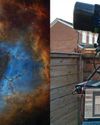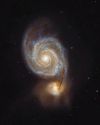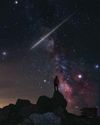
On 8 December 2022, Mars reaches opposition. It's going to be a splendid telescopic target, well-placed for observation in the Northern Hemisphere and well worth observing in the dark winter months. And as an added bonus, on the same night as opposition the Moon will appear to pass in front of Mars in an event known as a lunar occultation. December is set to be the month of Mars. But before then, Mars will be growing steadily larger and brighter, meaning there's plenty to see in the run-up. Here we'll explore the exciting phenomena we can observe before and after opposition.
Opposition occurs when an outer planet is opposite the Sun in the sky. Sun, Earth and planet all lie in a straight line, with Earth in the middle, and at this time the planet is due south at midnight and visible all night. We don't get a Mars opposition every year, nor are they all favourable for UK observers. This is due to the shape of the Martian orbit. All planetary Perihelic orbits are slightly elliptical, but the Martian one is more so than Jupiter's and Saturn's. As a result, Mars comes to opposition once every two years.
▲ At perihelion, Mars is at the closest point to us in its elliptical orbit. Aphelion is the opposite
The position of Mars in its orbit dictates its altitude in our skies at opposition. In a perihelic opposition, Mars is at (or near) perihelion (its closest point to the Sun). The planet is large and bright, but low down for Northern Hemisphere observers. In aphelic oppositions, Mars is at its furthest point from the Sun and has a small apparent diameter, but is high in UK skies. December's opposition is a transitional one: moving from perihelic to aphelic. In my opinion, these are the best: Mars reaches a good size and is fairly well placed.
Get your bearings
Diese Geschichte stammt aus der October 2022-Ausgabe von BBC Sky at Night Magazine.
Starten Sie Ihre 7-tägige kostenlose Testversion von Magzter GOLD, um auf Tausende kuratierte Premium-Storys sowie über 8.000 Zeitschriften und Zeitungen zuzugreifen.
Bereits Abonnent ? Anmelden
Diese Geschichte stammt aus der October 2022-Ausgabe von BBC Sky at Night Magazine.
Starten Sie Ihre 7-tägige kostenlose Testversion von Magzter GOLD, um auf Tausende kuratierte Premium-Storys sowie über 8.000 Zeitschriften und Zeitungen zuzugreifen.
Bereits Abonnent? Anmelden

Putting cosmic rays to work
These penetrating interstellar particles have applications from astronomy to archaeology

Set up your first imaging sequence
How to automate and coordinate your gear over multiple nights of imaging

The Universe without gravity
Life with no gravity might sound a fun idea, but as Govert Schilling explains, shutting off this pivotalforce would spell disaster for Earth and beyond

How to blend images taken with different camera setups
Combine data captured at varied focal lengths to create rich, deep images

INSIDE THE SKY AT NIGHT
Back in September 2021, The Sky at Night show spoke to Carly Howett about NASA's then upcoming Lucy mission. As the spacecraft now approaches its main targets - the Trojan asteroids - we check in with her to see how the mission is going

The science of SCI-FI
We love a good sci-fi film, but do they get the science right? Amy Arthur picks six of the big mistakes made in space films

Seeing in a new light
It's National Astronomy Week this month, so take a tip from Mark Westmoquette and let mindful stargazing change your perspective on your life and problems

What to do if you find a meteorite
Ever come across an unusual rock and wondered if it's a meteorite? Mark McIntyre explains how to tell if that stone really is a fragment from outer space

GEAR
Charlotte Daniels rounds up the latest astronomical accessories

Q&A WITH A STELLAR ECLIPSE SPECIALIST
Many stars are gravitationally locked inside multi-star systems, but a rare new triple-star system has set a new record for how cosy these clusters can get